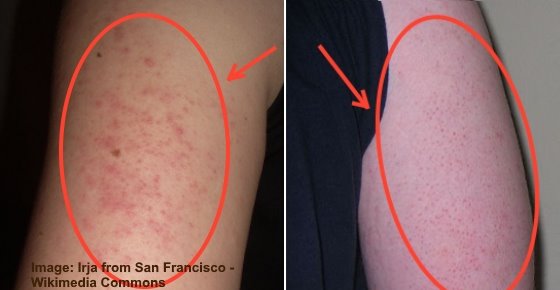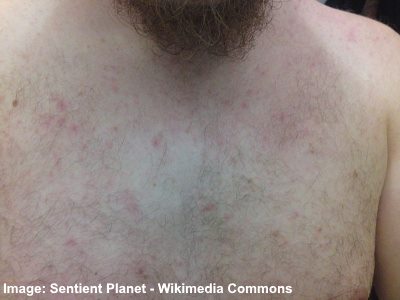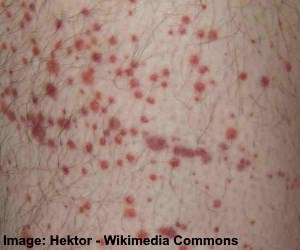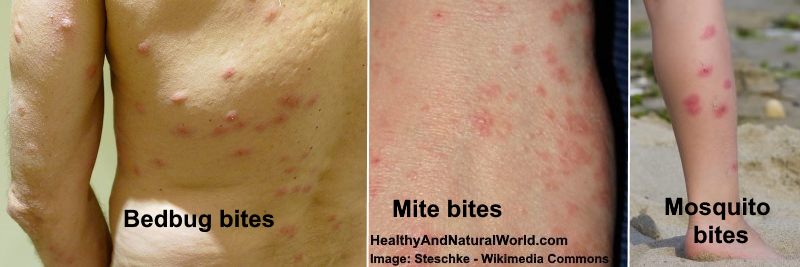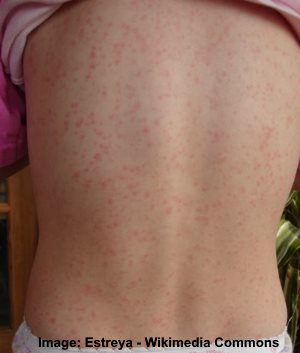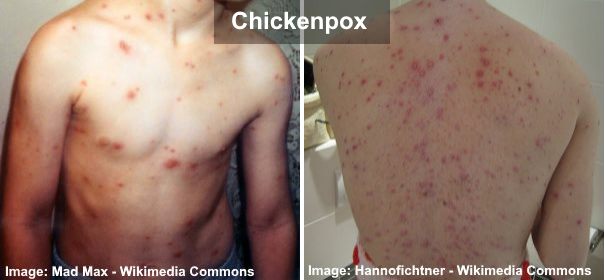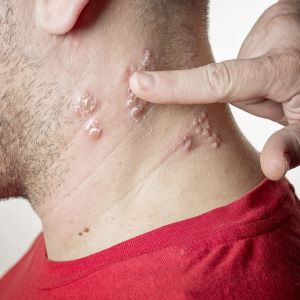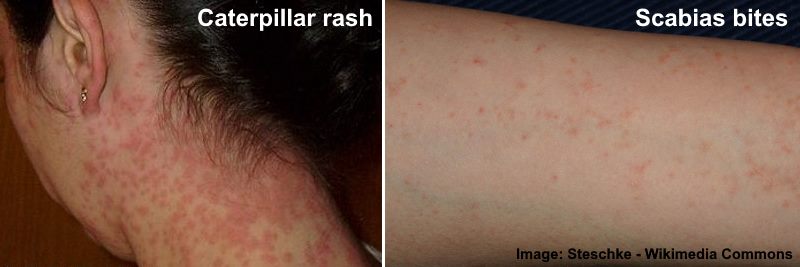Red Spots on Skin: Causes, Treatments and More (Extensive Guide)
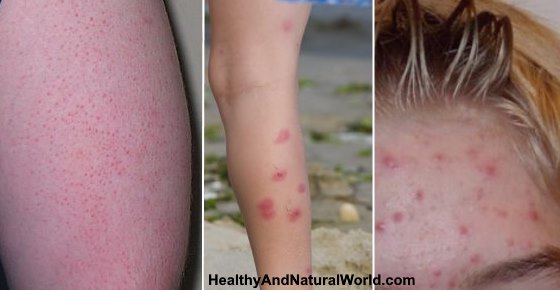
Red spots on your skin can appear as individual tiny red dots that look like pinpoints or are grouped together to form a red rash. Depending on the cause, the small flat or raised red spots may or may not be itchy. However, red itchy bumps on your skin could appear and become swollen and itchy if you’ve been bitten by a bug. Sometimes, bright red skin spots can develop and look like red moles.
There are many different reasons for noticing pinpoint red dots on your skin. Common causes of red itchy bumps on the skin are skin conditions like eczema, skin allergies, shingles, a heat rash, or reaction to an insect bite. This can result in patches of red itchy skin that can sometimes blister. Red spots on the skin that aren’t itchy could be caused by acne, boils, or keratosis pilaris.
Tiny red spots on your skin can appear anywhere on your body. Acne pimples are common on the face, back, or chest. But, pinpoint red dots under the skin caused by tiny blood vessels breaking could affect your legs, arms, face, stomach, or back.
In this article, I will examine the many causes of flat red spots or raised red bumps on the skin. In many cases, you will also find helpful home remedies to get rid of these unsightly red spots on your skin.
Symptoms of Red Spots on Skin
Red spots that appear on your skin can be flat or raised and can range in size from a tiny pinpoint to a large bright red mole. If the red bumps on your skin are the result of an allergic reaction, they will usually itch a lot. However, many flat red spots under the skin don’t itch at all and only cause visual discomfort.
Dr. Melissa Conrad Stöppler on MedicineNet says that other symptoms of red spots can include any of the following:26
- Outbreaks of tiny red spots that form a rash
- Raised red bumps called papules that are filled with pus due to an infection
- Flat red bumps called macules which can itch or cause no discomfort at all
- Patches of pinpoint red dots caused by straining or exertion
- Severe itching around a cluster of red dots
Causes of Red Spots on the Skin
Let’s look in more detail at what could be causing red spots on your skin.
Petechiae (tiny red spots on skin)
Doctors from the Mayo Clinic say that petechiae are tiny red pinpoint dots that appear on the skin when capillaries under the skin break and bleed. They usually appear in clusters and they are flat. These tiny red spots can appear on the face, neck and chest. But you may also find petechiae on legs, arms or on your eyelids.
Petechiae could be caused by prolonged straining during activities such as coughing, vomiting, giving birth and weightlifting. Petechiae can also be a result of taking certain medications or a symptom of the following infectious diseases:1
- Scarlet fever
- Strep throat
- Mononucleosis
Treating petechiae depends on the cause, and as conditions causing bleeding under the skin can be serious, it is usually best to see your doctor for a proper diagnosis.
If petechiae were the result of a viral or bacterial infection, the clusters of tiny red spots should go away when the infection is treated.
Red rashes characteristic of petechiae that are the result of medication should disappear when you change your medication or stop taking it.
Keratosis pilaris
Dermatologist Dr. Amanda Oakely says that keratosis pilaris can cause red dots on the skin that don’t itch or cause pain. The small red skin dots usually appear on the upper arms, cheeks, or buttocks. There is no cure for keratosis pilaris, but doctors recommend using skin products that don’t dry the skin.2
If you suffer from keratosis pilaris, you can try these home remedies for keratosis pilaris to lessen the symptoms, such as oatmeal scrub.
Acne
Acne is a common skin condition that causes persistent small to large red bumps on your skin. Dr. Debra Jaliman on WebMD says that red inflamed pimples filled with pus can affect the face, back, chest or upper back. Larger raised red spots are called papules and can become sore with a white head in the middle of a swollen red lump.3
Using acne treatments containing tea tree oil can help to get rid of acne naturally by killing off the acne-causing bacteria and reducing inflammation. You can also try these homemade acne face masks which contain many beneficial ingredients to reduce acne.
Eczema (atopic dermatitis)
According to Dr. Jeffery John Meffert on eMedicineHealth, eczema can cause red bumps of varying sizes that form an intensely itchy rash. Often eczema looks like a red rash that oozes fluid before crusting over. Sometimes the red bumps can look like fluid-filled blisters that give the affected area a “bubbly” appearance.4
Apply some virgin coconut oil to help soothe your skin and get rid of the itchy red patch that eczema causes. Also, witch hazel can help to improve the symptoms of redness, itching, and discomfort from eczema.
Psoriasis
Psoriasis is an inflammatory skin condition that causes itchy patches of reddened skin that look flaky. Dr. Gary W. Cole, a dermatologist at the University of California, says that a type of psoriasis called guttate psoriasis causes light red or pink bumps on the skin to form. These can be very itchy and there is a risk of the red bumps becoming infected if you scratch them. The red dots can be so numerous on the skin that they can form a large itchy patch.10
Many people have found that capsaicin cream can help to manage the symptoms of psoriasis and ease the discomfort that the itchy red bumps cause.
Hives
Doctors from the Mayo Clinic say that certain skin reactions can cause hives, which are large red bumps on the skin that can be very itchy. The raised red bumps become blisters and can appear suddenly and may take a few weeks to clear up. Depending on where the larger blister-like bumps appear, they can cause irritation and pain and may make your skin swell.5
Add 5 drops of chamomile or lavender essential oil to a tablespoon coconut oil and gently rub into your affected irritated skin 2 times a day for natural relief from hives. For more information, please read my article on getting rid of hives with natural remedies.
Angiomas (cherry angioma)
Bright red raised spots on your skin could be a type of red mole called a cherry angioma. Doctors from the American Osteopathic College of Dermatology say that the red bumps are caused by dilated blood vessels that form a bright cherry-colored mole. It’s not known what causes these harmless itchy red skin growths, but age may be a factor.6
For more information on red moles and their causes, please read my article on what you can do about red moles on your skin.
Heat rash
Doctors from the National Health Service say that a collection of small red spots that itch could be a symptom of heat rash. This is a raised itchy patch of red dots that can appear anywhere on the body. Usually, the itchy red spots are caused by sweat getting trapped in pores which leads to an itchy rash.7
Apply some oatmeal paste to the itchy patch of small red bumps to help treat a heat rash. This natural remedy helps to soothe the itching on your body and stop you from scratching so much.
Purpura
Dermatologist Dr. Amanda Oakley says that flat purple or dark red spots just under the surface of the skin could be purpura. Purpura can cause larger patches of darkened skin to appear where small blood vessels under the skin have burst.8
There are a number of reasons for red spots on your skin that cause purpura and your doctor will need to diagnose the cause to treat the underlying reason.
Boils
An infection under your skin can cause a large, painful red lump on your skin to appear that fills with pus. Doctors from the Mayo Clinic say that boils (furuncles) may start out as a small pea-sized bump. As the infection develops, the bump will get redder and increase in size. The boil will form a white tip that will burst and drain.9
Applying a damp warm compress regularly to the boil can help the boil to drain and heal quicker. Please read my article for more information on getting rid of a sore boil quickly.
Rosacea
Another reason for red spots on your skin that aren’t itchy is a chronic inflammatory skin condition called rosacea. The journal Dermatology Reports says that rosacea causes red pimples, pustules, and thickened patches of red skin to appear. Rosacea commonly affects the facial skin, and many red bumps together can appear as red patches on the face.11
To help reduce your symptoms of bumpy red spots on your face, apply some Manuka honey regularly as a healing skin mask. You can find more natural remedies for rosacea on my website.
Insect bites or stings
An insect bite or bee sting can cause a large red itchy bump on your skin to appear. Doctors from the National Health Service say that an insect sting can cause sharp sudden pain that develops into a swollen red lump. Usually, the itchy bumps on your skin will take up to 7 days to go away.12
Clusters of itchy bumps on your skin that look like mosquito bites could actually be from a bedbug infestation. Bedbug bites can cause tiny itchy red dots that may develop into a larger allergic reaction in some people.13
Add a little water to a spoonful of baking soda to form a paste and apply to the bug bites for instant relief. Baking soda helps to take the discomfort from insect bites and speed up the healing time.
Skin allergies
Allergies to certain irritants can cause contact dermatitis that results in an itchy red rash. The book Informed Health Online reports that the symptoms of skin allergies can be patches of red skin that itches or feels like it is burning. You may notice that you have very dry skin where the reaction occurred or red blisters may develop.14
It is important – and obvious – that you should avoid contact with the irritating substance. A cold compress or oatmeal bath can help soothe redness, itching and swelling. Or try to diffuse these essential oils for allergies.
Scarlet fever
According to PubMed Health, scarlet fever is a bacterial infection that causes a range of symptoms including a rash made up of red spots on the skin. The rash may have a rough feel to it like sandpaper and can be itchy for many children. Other symptoms include a sore throat with a bright red tongue, swollen lymph nodes, enlarged tonsils, and general fatigue.15
Your doctor will prescribe you a course of antibiotics to treat scarlet fever and prevent complications such as rheumatic fever.27
Chickenpox
A rash that starts out as small red dots on the skin that gradually cover most of the body could be a sign of chickenpox. Doctors say that red bumps from chickenpox first appear on the face and upper body. One of the main complications of chickenpox, apart from a rash of red bumps, is the intense itching it causes.16
Chickenpox is a highly contagious viral infection that can easily be spread among persons. Once a person has been ill with chickenpox, the virus can lay dormant in the body and reappear in later life as shingles.
Shingles
According to PubMed Health, the first symptoms of shingles are not tiny itchy red spots on the skin, but fatigue and a tingling sensation under your skin. After a few days, patches of red bumps appear on your upper body that eventually blister and crust over. Doctors say that a shingles rash looks like a red band that affects just one side of the body.17
The antiviral and soothing properties of honey make this a great natural remedy for getting rid of the itching that shingles causes. You can also make your own homemade healing ointment with essential oils for shingles to help relieve itching from bumps all over the body.
Folliculitis
Doctors from the Mayo Clinic say that hair follicles that become blocked can develop into small red dots that are usually itchy. Depending on your skin type, the small red spots may form into a cluster of bumps and be sore or tender to touch. This is often a reason for red itchy bumps after shaving hair, commonly referred to as razor bumps.22
Other causes of red spots on skin
There are some other reasons why you might develop red spots on your skin.
Intertrigo. This causes skin inflammation that has an itchy rash made up of red dots on the skin. Intertrigo commonly affects folds of skin and commonly causes a rash in the armpits or under the breasts.18
Scabies. Tiny mites called scabies can cause tiny red itchy bumps that form a rash on your skin. Scabies is easily transferable and can even affect people who live in clean environments.19
For information on how to get rid of scabies, please read my article on the best home remedies for scabies.
Ringworm. Ringworm is a fungal infection that causes an itchy red patch with a dark red border. Sometimes, ringworm can form a collection of blisters that are itchy and require antifungal treatment to get rid of the infection.20
You can make an antifungal cream with tea tree oil mixed with coconut oil or aloe vera to help treat the symptoms of ringworm and get rid of the itchy skin rash quickly.
Syphilis. Syphilis is a sexually transmitted infection that can cause small reddish-brown sores on your skin. You may also have swollen glands and muscle aches. It’s essential to get the proper treatment for syphilis to prevent serious complications or spreading the disease to your partner.21
Red Spots on the Skin that are not Itchy
Many symptoms of small red dots on the skin don’t cause any discomfort and are not itchy at all. Here are some types of red spots on the skin that don’t itch:
- Keratosis pilaris. Rough patches of tiny red bumps that are painless and don’t itch at all. The rash-like patches may get worse in drier air.
- Petechiae. Pinpoint flat red spots on your skin that are not itchy and can be symptomatic of a number of health issues.
- Rosacea. This inflammatory skin condition shows up as raised red bumps and sometimes look like acne pimples. You may notice that you have constant redness on your face, especially on your nose and cheeks.
Itchy Red Spots on the Skin
Because red itchy dots on the skin are often a result of an infection or cause irritation, red bumps are usually itchy. Here are some of the most common:
- Eczema. Intense itching of the skin that develops into a rash of bumpy spots of varying sizes.
- Hives. Hives can cause large itchy bumps that are more like blisters rather than spots. The itching these fluid-filled bumps can cause may be severe.
- Insect bites. Histamine that is released by the body causes inflammation that causes itchy bumps on the skin that look like mosquito bites. The itch and redness are usually localized to the site of the bite.
- Chickenpox. Patches of intensely itchy red dots on the skin that can appear anywhere on the body. The little red spots become blisters and then scab over.
- Shingles. Tingling, itching, prickling, or scratchy tiny red bumps are just some of the terms that people use to describe the discomfort of shingles bumps.
- Allergies. Most allergic skin reactions that cause red spots on the skin are itchy.
Tiny Red Spots on Skin
Pinpoint red dots on the skin are common if tiny capillaries have broken under the skin. The collective name for these patches of little red dots under the skin is petechiae. Sometimes, you may notice just one or two tiny red spots or you may notice that many minuscule dots cover a larger area of skin. Other causes of tiny red spots may include cherry angiomas that can range in size from a pinpoint to few millimeters in diameter, as well as Keratosis pilaris which causes numerous tiny small bumps on the skin.
Pictures of Red Spots or Dots on Skin
Comparing pictures of red dots or bumps with the red spots on your skin can help you identify the cause of the dots.
Pictures of red spots on the bottom or side of feet can help to know if the itchy red bumps were the result of a fungal infection or insect bites. Sometimes red or purplish spots on the side of your feet can indicate a problem with your circulation.
Looking at pictures to see what allergy spots, eczema, hives, or bug bites look like can also help you know the best kind of treatment for red spots on the skin.
Treatment for Red Spots on Skin
There are many ways to treat the symptoms of red dots, bumps, and spots on your skin. In some cases, you need to address the underlying cause to get rid of the unsightly bumps. However, some natural ingredients help to soothe irritated and itchy skin bumps and also kill off infections.
Aloe vera for red dots on skin
A study in 2015 into the healing properties of aloe vera found that aloe vera gel contains many anti-inflammatory properties. Researchers discovered that aloe vera helps to moisturize the skin and also bring down redness. In fact, applying aloe vera to your skin has the same effect as many antihistamines and topical corticosteroids.23
How to use:
- Apply aloe vera gel directly to the irritated red bumps on your skin to relieve itching, redness, and swelling.
- Use 2 or 3 times a day until the red dots on your skin have gone.
Even in skin conditions where it’s not possible to completely get rid of the tiny red dots, aloe vera can help to keep your skin in good condition.
Coconut oil and tea tree oil for skin infections
Another natural remedy to help treat red itchy bumps that are caused by an infection or acne is to apply a homemade ointment of virgin coconut oil and tea tree oil.
For example, the journal Dermatitis reported that coconut oil has antibacterial properties that help to reduce the symptoms of skin inflammation. It was reported that coconut oil can help to relieve dermatitis and similar skin conditions.24
Also, tea tree oil is a well-researched natural antimicrobial remedy that can help to kill off various bacterial and fungal infections. The journal Clinical Microbiology Reviews reported that tea tree oil is antifungal, antibacterial, and can help reduce redness from inflamed skin.25
How to use:
- Add 2 or 3 drops of tea tree essential oil to 1 tablespoon virgin coconut oil and mix well.
- Massage the tea tree oil/coconut oil salve to areas of your skin where you have patches of red spots or bumps.
- Apply 2 or 3 times a day to help relieve itching and get rid of small to large red bumps that are the result of an infection.
Read these related articles:
- What Causes Red Moles on Skin and How to Get Rid of Them
- How to Get Rid of a Rash: The Best Home Remedies (Research Based)
- How To Get Rid Of Eczema: 13 Natural Remedies Backed By Research
Medical Sources

